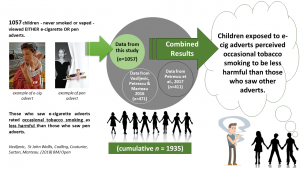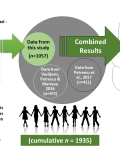Our research on smoking
Our research on tobacco has focused largely on how altering physical environments might positively change behaviour, thereby aiding in or helping to sustain cessation attempts.
Click on the images below to find out more about the work we have been doing in this area.
Key Studies
Visual Abstract of Vasiljevic et al., 2018 In two previous studies, we found that children exposed to e-cigarette adverts perceived occasional tobacco smoking as less harmful than children not exposed to such adverts. In this paper, we replicate and extend these findings using a larger sample, a stronger control condition and an updated meta-analysis. We found that children exposed to e-cigarette adverts depicting glamour perceived the harms of smoking one or two tobacco cigarettes occasionally to be lower than did those exposed to unrelated adverts. An updated meta-analysis comprising three studies (including the present study) with 1,935 children confirmed that exposure to different types of e-cigarette adverts [glamorous, healthful, flavoured, or non-flavoured] reduces children’s perceptions of the harm of occasional smoking of one or two tobacco cigarettes. E-cigarette Adverts and Children’s Perceptions of Tobacco Smoking Harms: An Experimental Study. Vasiljevic, St John Wallis, Codling, Couturier, Sutton, Marteau, 2018. Children shown the adverts were no more or less likely than the control group to perceive tobacco smoking as appealing and all three groups understood that smoking more than ten cigarettes a day was harmful. However, both groups of children exposed to the e-cigarette adverts, both healthy and glamorous, were less likely to believe that smoking one or two tobacco cigarettes occasionally was harmful. What is the impact of e-cigarette adverts on children’s perceptions of tobacco smoking? An experimental study. Petrescu, D, Vasiljevic, M, Pepper, JK, Ribisl, KM, Marteau, TM. The children shown the ads for candy-flavoured e-cigarettes liked these ads more and expressed a greater interest in buying and trying e-cigarettes than children shown the non-flavoured ads. Importantly, showing the ads had no impact on the pre-existing low levels of appeal of smoking tobacco or using e-cigarettes – in other words, how attractive, fun or cool they considered the activities. Impact of advertisements promoting candy-like flavoured e-cigarettes on appeal of tobacco smoking amongst children: an experimental study. Vasiljevic, Petrescu & Marteau. 2016. We note the promising use of reward-based schemes (but not penalties) for promoting sustained quitting, particularly among the poorest thereby reducing health inequalities but argue that such schemes are unlikely to be used until efforts are made to increase their public acceptability. Public health: The case for pay to quit. Marteau & Mantzari. 2015. Financial incentives are effective in helping people This systematic review and meta-analysis showed financial incentives can motivate people, especially those from deprived backgrounds, to change behaviours that are bad for their health. The impact of financial incentives lasted maximum of three months after their removal and only when offered for stopping smoking, particularly during pregnancy. Personal financial incentives for changing habitual health-related behaviors: A systematic review and meta-analysis. Mantzari, Vogt, Shemilt, Wei, Higgins, & Marteau. 2015. We replicated this study in the UK to see whether the close proximity, or density of tobacco outlets near smokers’ homes affected quitting success in both Birmingham and Bristol. In our study, neither of these factors affected whether people successfully quit smoking. Impact of tobacco outlet density and proximity on smoking cessation: A longitudinal observational study in two English cities. Han, Alexander, Niggebrugge, Hollands, & Marteau. 2013. We carried out a study on shops across London and found evidence of widespread marketing and availability of e-cigarettes in-store. The sale and use of e-cigarettes is likely to lead to more images of objects that look like cigarettes being shown, which could have the potential to re-normalise smoking. An observational study of retail availability and in-store marketing of e-cigarettes in London: potential to undermine recent tobacco control gains? Hsu, Myers, Ribisl & Marteau. 2013. Our review highlights that: Altering micro-environments to change population health behaviour: towards an evidence base for choice architecture interventions. Hollands, Shemilt, Marteau, Jebb, Kelly, Nakamura, Suhrcke & Ogilvie. 2013. How do different types of e-cigarette adverts affect perceptions of harm from tobacco smoking among children?

Children exposed to vaping ads are less likely to think occasional smoking is bad for health
 We assigned 564 British children to one of three groups where they either saw: adverts depicting e-cigarettes as glamorous; adverts depicting e-cigarettes as healthier alternatives to tobacco cigarettes; or no adverts (control group).
We assigned 564 British children to one of three groups where they either saw: adverts depicting e-cigarettes as glamorous; adverts depicting e-cigarettes as healthier alternatives to tobacco cigarettes; or no adverts (control group).Do candy-like flavoured e-cigarettes adverts encourage vaping among schoolchildren?
 In this experiment we assigned schoolchildren to one of three groups where they either saw: adverts for candy-like flavoured e-cigarettes; adverts for non-flavoured e-cigarettes; or no adverts (control condition).
In this experiment we assigned schoolchildren to one of three groups where they either saw: adverts for candy-like flavoured e-cigarettes; adverts for non-flavoured e-cigarettes; or no adverts (control condition).
Paying people to quit smoking: Potent but repugnant?
 In this commentary we discuss the findings from a large randomised controlled trial of four financial incentive schemes for smoking cessation, published in 2015 in the New England Journal of Medicine.
In this commentary we discuss the findings from a large randomised controlled trial of four financial incentive schemes for smoking cessation, published in 2015 in the New England Journal of Medicine.Can financial incentives help people, especially pregnant women, to quit smoking?
 to change their unhealthy behaviours, including stopping smoking. It is not known whether these changes are maintained after incentives stop.
to change their unhealthy behaviours, including stopping smoking. It is not known whether these changes are maintained after incentives stop.
Does proximity and density of tobacco outlets impede quit attempts?
 A study from the US suggested people who live closer to tobacco outlets are less likely to successfully quit smoking.
A study from the US suggested people who live closer to tobacco outlets are less likely to successfully quit smoking.How widespread are images of e-cigarettes?
 E-cigarettes may help smokers quit, but they also increase the quantity of smoking-related images in the public domain which may ‘re-normalise’ smoking.
E-cigarettes may help smokers quit, but they also increase the quantity of smoking-related images in the public domain which may ‘re-normalise’ smoking.Do interventions to change our environment reduce tobacco consumption?
 We carried out a systematic scoping review of studies investigating the effects of physical environment interventions on behaviours, including smoking. Such interventions include changing the packaging of cigarettes or reducing the number of outlets selling tobacco.
We carried out a systematic scoping review of studies investigating the effects of physical environment interventions on behaviours, including smoking. Such interventions include changing the packaging of cigarettes or reducing the number of outlets selling tobacco.
Publications relating to smoking
2018
2017
2016
2015
2014
2013








